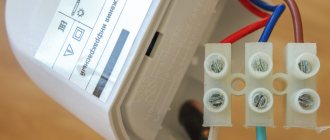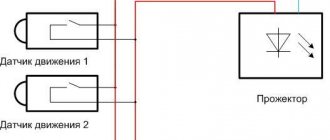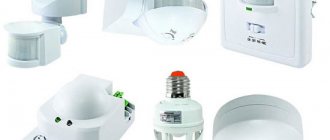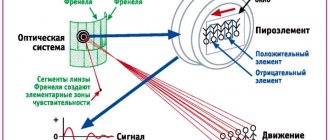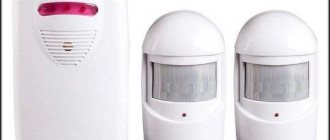Motion sensors are lighting system control devices that respond by turning on the power supply to the movement of objects in their “sector of responsibility.” Not so long ago, such devices were used only in security systems of various organizations. But now it is a technology accessible to everyone. They perform well in lighting local areas. Motion sensors are widely used in residential buildings, private and multi-apartment buildings, significantly increasing the operating comfort of lighting systems. In addition, thanks to such improvements, significant savings in energy consumption can be achieved.
How to connect a motion sensor to an LED floodlight
The assortment of stores offers many lighting devices already equipped with a motion sensor. Installing them is, of course, easier. But often there is a need to separate the lighting device and the sensor over a certain distance. In principle, this shouldn’t cause any difficulties either. In this article we will look at how to connect a motion sensor to an LED floodlight, used, for example, to illuminate a yard.
How the motion sensor works
Motion sensors are installed not only to illuminate the local area, but also inside the house itself. For example, a device installed on a staircase will turn on the lights only when it is really necessary - if someone is going up or down it.
Each sensor is designed for a specific sector located in its field of view. The principle of operation is simple - if movement of objects is detected in this area, then a circuit is closed that supplies power to the lighting fixtures. Therefore, the efficiency of the system is determined by the correct choice of installation location, that is, the creation of a “view” of the controlled area necessary under specific conditions.
Each motion sensor has its own characteristics of the radius and angle of the response sector
Lighting devices connected to the sensor can be turned on only while the object is moving in the sector, or with a subsequent turn-off delay from several seconds to 10÷15 minutes. This parameter is preset by the user.
How to convert a chandelier designed for a single switch into a double switch
If your chandelier is designed for a single switch, that is, only two wires come out of the base of the chandelier, and there are several lamps, and your electrical wiring allows it, you can try to convert the chandelier to a double switch. The process is labor-intensive, but the result is worth it.
Read also: Float system for water storage tank
In a chandelier of this design, all wiring from the lamps (shades) comes into one combination of phase and neutral wires. You need to find this place and divide the lampshades into two sections, each of which will be turned on by the corresponding switch key.
After we have found the connection point, do the following:
- The neutral wires remain connected to each other and do not need to be touched.
- We divide the phase wires into two groups of wires instead of one. The division scheme is at your discretion, depending on the number of shades and your personal preferences.
- Connect the common (neutral) wire with the neutral wire coming from the junction box.
- To connect the phase wires from the resulting sections of the lampshades of the sections, you need to run another additional wire from the chandelier to the place where the chandelier is connected to the electrical wiring from the double switch.
Thus, it is quite easy to transform an ordinary chandelier into a three-mode one.
Types of motion sensors
When choosing such lighting control devices, they are evaluated according to several criteria.
Sensor installation location
Everything is simple here - sensors can be designed for outdoor installation or for operation inside the house.
Outdoor sensors are designed to monitor areas adjacent to the house. They usually differ in quite significant perception range parameters. In some instruments it can be hundreds of meters. True, for use on the scale of the courtyard of a private house, such ranges are not particularly relevant.
The outdoor sensor is not necessarily installed next to the floodlight. Their relative location is planned taking into account the area and configuration of the territory, pedestrian path, access road, etc.
Such systems are convenient for owners when lighting the yard, for example, when returning home or leaving the house in the dark. The light will be turned on until the person leaves the sensor sector, and then automatically turns off. And for security purposes such a device will be useful. A bright spotlight that suddenly turns on will certainly scare off an intruder trying to get into the protected area under cover of darkness.
Indoor sensors are designed to work indoors in the home. They differ from external devices in their smaller viewing sector and poor protection from various types of atmospheric influences. It is clear that their cost is usually much lower.
Prices for motion sensors
Motion Sensor
Check out the requirements and automation options in our new article on our portal - “Lighting in the entrance”.
Built-in and separately located sensors
This criterion has many similarities with the above. But it already predetermines the initial constructive relationship between the sensor and the lighting device connected to it.
Spotlight with built-in motion sensor. Connecting such a system is the easiest way
- The lighting device itself and the motion sensor can initially be assembled in one housing. It is clear that this is the most convenient option for installation. All internal switching has already been completed, and all that remains is to connect such a spotlight to the laid power line.
A spotlight that comes complete with a motion sensor. Also, as a rule, there are no difficulties with connecting to the electrical network.
- The second option is that the motion sensor is placed in a separate housing, but attached to the spotlight. Such models are also quite simple to install. They are connected like a regular spotlight, since the switching of the lamp and sensor has already been carried out by the manufacturer.
Motion sensor installed separately, at a certain distance from the lighting fixture
- The motion sensor is made in a separate housing, which is installed in the optimal place for its operation. It is for such cases that a diagram for connecting the sensor to the spotlight is required.
The principle of responding to moving objects
According to the underlying principle of detecting moving objects, sensors can be infrared, ultrasonic, microwave and combined.
- Infrared sensors. The operation of these devices is based on monitoring temperature changes. When objects with elevated temperatures enter the sensor's tracking area, it reacts by turning on the power to the lighting fixture.
Infrared sensors are most often installed inside residential premises. And they are configured in such a way that they react to the movements of people, ignoring pets.
This type of device includes a set of special mirrors and lenses that affect the sensor. The sensitivity of the sensor depends on how many lenses it has, and there can be up to thirty pairs of them in one device.
Special multilenses allow you to track the movement of “warm” objects over a wide sector.
Infrared sensors have their positive and negative sides, expressed in the following features:
| Advantages | Flaws |
| The devices allow you to determine the range and angle of the response sector as accurately as possible. | When installing a sensor in a house, it is possible that the sensor will trigger falsely when the temperature in a certain zone increases. These “troublemakers” are often portable heaters and heat-emitting household appliances, such as an electric kettle. |
| The infrared sensor only reacts to objects with elevated temperatures, so it can be used for installation outside buildings. | The device may malfunction due to atmospheric conditions. |
| Complete safety of the sensor for human and pet health. | The device may not respond to materials that are resistant to infrared radiation. |
| Small adjustment range. |
- Ultrasonic sensors. The operation of this type of device is based on the reflection of ultrasound from the surfaces of various objects. This principle of operation of the sensor allows you to determine moving objects by changing the frequency of reflected pulses (Doppler effect). This device detects ultrasound, which is inaccessible to human hearing.
Let us list the “pros” and “cons” of such devices
| Advantages | Flaws |
| Devices of this type are resistant to atmospheric influences. | There is a rather limited range of action. |
| The ability to respond to the movement of any objects - animate or inanimate. | The devices react only to active movement. Slow movement is often ignored by sensors. |
| Affordable cost of sensors. | Causes a negative reaction in pets that are sensitive to ultrasound. |
- Microwave sensors . The operating principle of these devices is based on radar. That is, they send a pulse and receive a reflected signal, just like ultrasonic ones. But only the signals already lie in the radio frequency range.
Microwave sensors are considered more advanced than their ultrasonic “competitors”. They are more sensitive and less susceptible to atmospheric interference.
| Advantages | Flaws |
| High sensitivity to any movement of living or inanimate objects. The ability of microwave sensors to detect movement even behind a thin wall or behind glass. | High sensitivity can also be attributed to the disadvantages of the sensor, since it can also respond to movements occurring outside the monitored area. |
| Resistant to all weather conditions. | High cost of devices. |
| Ability to serve several areas of the territory at once. | Microwave radiation is not good for human health. |
- Combined motion sensors. The design of these devices uses two or even all three principles of its response to the appearance of moving objects in the area of responsibility.
Control in a dedicated sector using such devices is carried out more effectively than when using “narrow-profile” sensors. Therefore, we can say that they are the most perfect. But this is also high cost, as well as the harm of microwave radiation to human health, if the sensor has such a motion recognition system. In this regard, you can more often find sensors on sale that include an ultrasonic and infrared sensor.
How to setup
Almost all devices have a number of settings that allow you to adjust their operation and set the optimal mode. Adjustable:
- installation angle;
- illumination;
- sensitivity;
- delay mode.
Proper adjustment of a floodlight with a motion sensor will save up to 50% of energy consumption.
Installation angle
You can increase the area of the controlled area by correctly constructing the installation angle. To do this, you need to select the height at which the floodlight with a motion sensor for the street will be mounted. So, with the same height and different angle values, the coverage area of the device will also be different.
Sensitivity
The most difficult type of adjustment is sensitivity. On the device body it is designated as “sens”. Adjustments must be made in such a way that the detector does not react to animals. This is most often realized experimentally. The “sens” button is displayed at the maximum value, after which the sensor response begins to be checked until the optimal option is found.
Illumination
This setting is configured to turn on the light only during twilight or dark conditions. To adjust the illumination, use the “lux” button. It is this adjustment that will save on electricity bills.
Delay time
This individual setting can be made in a fairly wide range: from 5-10 seconds to 3-5 minutes. The delay time is set with the “time” button.
What else do you pay attention to when buying a motion sensor?
If you have not yet purchased a motion sensor for a spotlight, then when choosing one, in addition to the features of the devices listed above, you should pay attention to the manufacturer and some characteristics that are important for operation.
Prices for LED spotlights
LED Spotlight
- Among the companies that are popular with consumers due to the quality of their products are “Theben” and “Brennenstuhl” (Germany), “Orbis” (Spain), Russian brands “Camelion”, “Feron”, “TDM”, “ ERA". Many of the listed devices are assembled in China, but there are no particular complaints about the quality. And purely Chinese brands “Ultralight” or “REXANT” are also considered quite worthy and competitive models.
- The permissible load power must be at least not lower than the power consumption of the spotlight intended for joint installation. In general, it’s better to have a certain reserve, about 30%.
- For outdoor placement, it is necessary to select sensors that have a housing protection class of at least IP44.
- The most important parameters are the operating range and the angular width of the viewing sector.
- The manufacturer may indicate a recommended sensor installation height. This recommendation should be followed so that the automatic light switching system works correctly, without failures and “idle” starts.
- High-quality devices have several adjustment controls - turn-off time delay and sensor sensitivity. In inexpensive models, these parameters can be preset and cannot be adjusted. This can be very inconvenient to use.
- Another adjustment element may be changing the light level for the device to operate. As a rule, a photo relay is included in the design of the motion sensor. That is, the device will respond to movement by turning on the light only in low light conditions, below a preset level. Agree, there is no point in operating such a system during the day.
If there is no photo relay, then you will have to turn the power on and off manually every day. Or still purchase an additional photo relay and include it in the overall circuit. How this is done will be shown below.
Device Specifications
The technical characteristics of wireless models also include the frequency at which they operate and the type of batteries
Technical characteristics are indicated in the technical documentation (in the passport), which accompanies any technical product, otherwise it is unlikely that it will be possible to select the necessary device.
Viewing angle
There are products with different viewing angles, both in the vertical and horizontal planes. If it is necessary to protect an object from different sides, then sensors with a viewing angle of up to 360 degrees are used. If the sensor is mounted on a wall, a device with a viewing angle of 180 degrees is sufficient. If you plan to install the sensor on a pole, then it is better to give preference to a viewing angle of 360 degrees. In this case, it all depends on what area and what object or group of objects is planned to be protected. When installed in an apartment, to protect individual rooms, sensors with a smaller viewing angle, about 90 degrees, are chosen.
Depending on the installation location and the required detection zone, select the viewing radius
If there is one entrance to the room, it is enough to install a sensor with a narrow viewing angle, otherwise you have to install several sensors with a narrow viewing angle or one sensor with a wide viewing angle. It should be remembered that such sensors are not cheap, so you should always focus on economic feasibility.
There is also such a thing as vertical viewing angle. In simple, inexpensive models, this figure is no more than 20 degrees. For more expensive models, this figure is much higher and can be all 180 degrees. Such devices are used in security systems where such costs are justified. In lighting systems, the simplest and cheapest device is sufficient. The main thing is that the sensor is installed at the desired height and turns on the lighting under certain conditions.
Radius of action
The range should be selected with reserve
The choice of motion sensor based on its range depends on where it will be installed: outdoors or indoors. For indoor use, devices with a range of about 5-7 meters are sufficient. If the sensor is installed in a yard or other location, certain factors must be taken into account, otherwise false alarms may occur. Sensors with a long range can be triggered when people move along the street, when a neighbor appears in their yard, etc. Therefore, in such cases, it is better to opt for devices with a minimum range.
Power of connected lighting sources
The sensor power should be calculated with a reserve
Each sensor is designed for a certain load power, which it can turn on/off without emergency modes. Otherwise, the device will simply fail because the controls will not withstand it.
Recently, this indicator is not so critical, since people are switching to more economical lamps, such as energy-saving or diode.
Mounting method and choice of installation location
Most often, sensors are mounted on the wall.
Motion sensors may also differ in the method of attachment. Therefore there are:
- Case products, in the form of a small box with a bracket. Such models are attached:
- On the ceiling.
- On the wall.
- Built-in models designed for hidden installation.
Such models are distinguished by the fact that they are small in size, which allows them to be installed unnoticed by others.
If you just need to turn on/off the lighting in the right place, then you can get by with cheaper cabinet-mounted devices. Miniature built-in sensors are more suitable for security systems, especially since they are also expensive.
Additional features
Some models, depending on the purpose and operating conditions, have additional functions. These functions include:
- Sensitivity threshold. It is implemented using a light sensor, in the form of a photo relay. This sensor is especially useful when installing the device outdoors. This function is necessary to ensure that the device turns on the lighting only at night.
- Protection from animals. Naturally, in every private yard there are cats and dogs. The function is necessary in order to reduce the number of false alarms when animals move. If there is a large dog in the yard, this function may not work.
- Shutdown delay. There are different devices, both with and without delay. In most cases this function is adjustable. It is quite inconvenient if a person often moves within the sensor’s coverage area, but also often leaves it, and the motion sensor also often turns the lighting on and off.
Schemes for connecting a motion sensor to a lighting device
When starting this section, you should immediately note the following. Despite the variety of models, almost all motion sensors are connected to lighting fixtures in a similar way. The exception is lamps that require voltage conversion. But here the whole difference is that the power supply is included in the circuit.
Prices for LED lamps
LED lamp
In most motion sensors, the arrangement of contacts on the terminal is as shown in the illustration
The standard connection system for the vast majority of motion sensors is a three-pin terminal. Two of them are the usual phase (L) and zero (N). The third contact can be indicated by the letter “A”, “L out” or even just an outgoing arrow → . But in any case, this is also a phase, but this one goes to the lighting device when the sensor is triggered.
A. Here is the simplest diagram for connecting a motion sensor to an LED spotlight.
The simplest circuit for connecting a motion sensor and a lighting device
A few clarifications. The power cable of a 220 volt network combines three conductors. Brown (in the diagram, in reality it may have a different color) - phase L , blue - zero N , and green-yellow - protective grounding PE .
PE grounding goes directly to the spotlight - since in most cases there is a metal case, this measure is a necessary condition for safe operation.
Zero N is switched equally to the corresponding terminals of both devices.
The phase goes to terminal contact L of the motion sensor.
And finally, from contact A of the sensor terminal, when the device is triggered, the phase will be supplied to contact L of the spotlight. Thus, when the circuit in the motion sensor is closed, the lighting device will turn on.
B. The diagram shown above assumes direct connection of the “spotlight + motion sensor” system to the electrical network. But often a switch is also provided. By the way, there may be different options with it.
So, the following diagram demonstrates that the switch can be installed in a phase break going to the terminals of the motion sensor.
Circuit with a switch that completely turns off the entire system
It is quite obvious that when the switch is in the off position, the power is interrupted completely. That is, the motion sensor itself does not work and, accordingly, the phase cannot reach the spotlight. When turned on, the system operates in its characteristic “standby mode”, that is, it reacts by turning on the light to movement in the “sector of responsibility”.
B. But this arrangement of the switch in the circuit, as shown below, has a completely different purpose.
In this circuit, the switch allows you to switch to a conventional lighting system, without reference to the sensor
It is clearly visible that the power to the motion sensor is not interrupted. When the switch is in the “off” position, that is, with open contacts, the system operates in its characteristic mode, that is, the sensor controls the activation of the spotlight. But there are often situations when it is necessary to illuminate an area of the yard, so to speak, on an ongoing basis - performing certain chores at dusk, receiving guests, etc. That is, there should be no dependence on the activation of motion sensors. It’s simple - when the switch is on, the light will be on constantly, since the phase along the section of the circuit shown in purple in the diagram goes directly to the spotlight, bypassing the sensor.
D. The circuit can also be used with a two-key switch. Then, as necessary, you can select the most appropriate operating mode of the system at the current moment.
The “spotlight + motion sensor” system is connected via a two-key switch
What happens with this scheme:
— When both keys are turned off, the system is completely de-energized.
— Turning on key No. 1 puts the system into the mode of tracking movement in a given sector and turning on the spotlight based on the sensor.
— Turning on key No. 2 (regardless of the position of key No. 1) simply directly turns on the spotlight.
D. Sometimes the complex configuration of the territory (premises) forces the installation of two motion sensors, or even more. In this case, they are placed so that the “sector of responsibility” of one intersects with the area of the other. That is, a moving person is constantly in the field of view of the devices.
In such cases, it is most convenient to connect motion sensors in parallel. An example is shown in the diagram below.
Parallel connection of two motion sensors
It is clear that in operation both devices are completely independent of each other, but each of them is equally capable of controlling the spotlight.
A scheme for sequential connection of sensors is less commonly used, when the phase to each subsequent device comes from the control terminal A of the previous one. It is unlikely that this method would be appropriate in the yard in combination with a spotlight. Therefore, there is no particular point in providing a diagram.
E. _ It has already been said above, but let us clarify that most household motion sensors are designed to operate on a 200 V network. But for one reason or another, it may be necessary to connect a lamp that requires a constant low voltage (12, 24 or 36 volts). This is often practiced, for example, in garages and other outbuildings that require increased security measures.
This means that the scheme is slightly modified.
Scheme for using a motion sensor with a lighting device that requires connection to a DC source
The working zero and grounding conductors are connected to the power supply. And the phase is supplied to it according to the same principle as shown above - through a motion sensor. And the DC voltage is removed from the power supply, which is transmitted to the lighting device while maintaining polarity.
G. Another scheme that in modern conditions rarely has to be resorted to, but still... This is in case you happen to be dealing with an outdated model of a motion sensor that does not have its own built-in photo relay. It turns out that if you leave such a system in working order during daylight hours, the device will still turn on unnecessary lighting when it detects a moving object.
Turning off the power in the morning and starting it up in the evening is often simply forgotten. The problem is solved by installing another device in the circuit - a photo relay. This, by the way, is exactly the device that automatically turns on the street lighting at dusk.
A circuit with a separate photo relay will look like this:
Serial connection diagram of photo relay and motion sensor
There is nothing complicated. Moreover, the principle of the arrangement of contacts on the photo relay terminals is exactly the same as the motion sensor.
It is important that the phase from the power supply comes exactly to the L of the photo relay. And then from the output terminal A it is supplied to the input L of the sensor. And then - according to the scheme already known to us.
The automatic photo relay is configured (or allows it to be configured) to a certain level of illumination. As soon as it falls below the set limit, the relay is triggered and the phase goes to the motion sensor. That is, during the day it stands without power, but at dusk it comes into operation. And when power is supplied to it, it begins to track the movement of objects in its sector, closing the spotlight’s power circuit if necessary.
* * * * * * *
All basic schemes for connecting a motion sensor to a lighting device were considered. It can be noted once again that despite the very wide variety of models, the principle of their connection remains common.
Different models both in design and installation location. But at the same time, the principle of their electrical switching with the lighting device is the same.
In addition, if the device is purchased in a store, instructions will definitely be attached to it. It usually describes in detail all aspects of installing a motion sensor - mounting in place, electrical switching and final fine-tuning of the adjustable parameters.
It's difficult to add anything. Unless you can just watch a video in which the master gives a short overview of the FERON Sen 11 infrared motion sensor. And then he shows the principle of its inclusion in a circuit with a lighting spotlight. After watching, everything should become completely clear.
Video: How to connect and test the FERON Sen 11 motion sensor
* * * * * * *
So, connecting a motion sensor to a spotlight or a regular lamp usually does not cause difficulties even for novice craftsmen. In addition, each manufacturer necessarily provides the buyer with instructions and a diagram for assembling the system, which simplifies the task even more. But when carrying out work, in addition to the recommendations of the instructions, all safety requirements must be observed. Electricity does not like and often does not forgive negligence, disregard for rules and other “jokes”. All electrical installation operations should be carried out only after the technician has ensured that the wiring in the work area is de-energized.
